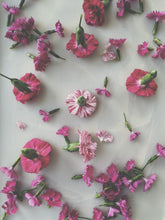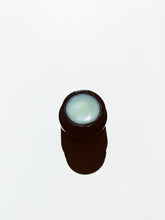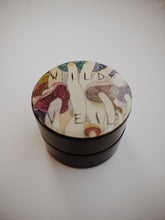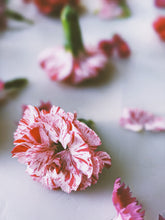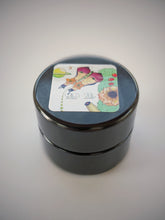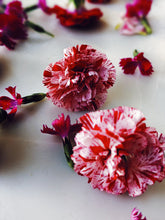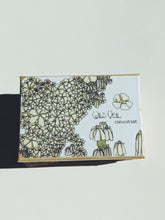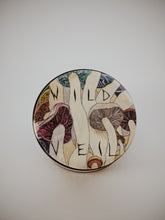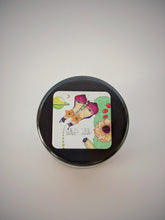
Organic Dianthus Enfleurage.
A dianthus soliflore (single note perfume) handmade using a cold enfleurage of dianthus flowers and avocado butter. The dianthus from my spring/summer gardens went into this enfleurage. The result is an organic dianthus solid perfume-- a rarity. The scent is creamy, rich, and spicy. Like carnation, it features clove notes, but my dianthus has deep, edible vanilla notes, moreso than is typical of carnation. It almost crosses over into the sweet pastille territory of Viola odorata. I have a limited quantity.
Literally, "in flower," enfleurage is a traditional, labor intensive, and pure method of extracting fragrance, utilizing only fat and plant material. Enfleurage is also the method of perfume extraction that most closely replicates the odor profile of the original flower: each flower's complex fragrant arc from bud to bloom is imprinted in fat, where it is stored. The scent is true to the blossom, but subtle, requiring you to bend in close for a sniff.
I have used enfleurage to capture dianthus's gentle, creamy, spicy aroma. Enfleurage produces a "pommade," which is a highly scented solid perfume and not to be confused with pomade for hair! This pommade consists of hundreds of individual organic dianthus blossoms that I gathered from my perfume gardens, laid onto organic avocado butter. They are left to breathe on the fat through their fragrant lifespan, then removed, washed, and dried. I repeat this process to reach a high degree of fragrance saturation. Each reposition is a "charge," and this enfleurage was charged the traditional 36 times. The aroma is velvety, spiced vanilla cream. To me it feels like English tea and clove cakes. It is very much the opposite of the shrill, overpowering version of a synthetic floral you find at the fragrance counter. Only you and those closest to you will be able to smell it. Apply to pulse points.
Wild Veil's natural perfume fixatives act as primers for the skin. Applied prior to perfumes, they can extend the longevity of your fragrance. Suggested fixatives:
Amber fixative contains classically amber base notes from my handmade resinoids that I extracted from raw, wild resins using organic high proof alcohol. It is warm, powdery, and slightly boozy. Resinous with caramel undertones.
Animalic fixative features stunningly intense musk base notes. If you are looking to enhance the tenacity of your natural perfumes, and to fix volatile florals and top notes, this is a fixative worth investing in. Luxurious and powerful, its sleek fur coat undresses to warm amber powder underneath.
Botanical Musk fixative contains musky base notes. It is slightly dry and earthy, with intimate notes of skin, hair, and smoky roots.
Conifer fixative contains stirring and wintry evergreen base notes from my handmade tinctures and absolutes of wild Vermont conifers, with many boughs collected from wild stands in my old growth forest: blue, red, white, black, and Norway spruces; fir balsam; Northern white cedar; white pine; scotch pine; and Eastern hemlock. The blend is a complex, deep green and balsam thanks to the various tree parts I have extracted: bark, boughs, needles, and resin/sap. In the background is the cool, fresh, early spring of brisk forest air scented with sticky sap and the snap of firewood.
Dew fixative features light, springy, and dewy notes redolent of sunrise on sprouting blades, droplets cradled by meadows, and the brief post-dawn lingering of wet cobwebs in field grasses.
Dry fixative possesses dry base notes. It crackles with a warm, subtly smoky aroma, and smooth resins layered over a gently bracing botanical musk.
Earthy fixative contains earthy base notes. It is green and smoky, with the comforting aroma of wet musk from the depths of the earth.
Ferns fixative, made with mise en lieu tinctures of wild ferns from both the moist De Luz jungle and Vermont old growth forest. The scent is wet, damp, lush, and cool.
Gourmand fixative contains gourmand, or edible, base notes of vanilla Madagascar, cocoa, and frangipane. It is not overly sweet, but rather dark and sultry, with a hint of sugar. The compounds used to scent the paste include my handmade absolute of raw, wild cacao beans (Theobroma cacao) from Peru, and my absolutes of bourbon vanilla Madagascar (Vanilla planifolia) and Vanilla tahitensis (Tahitian vanilla). The bourbon is from vanilla beans that I grew at home on my vanilla orchid vines by hand pollinating the flowers. I then cured and tinctured the beans in high proof organic alcohol, producing a completely organic absolute.
Grass fixative, made with a mise en lieu tincture of Vermont wild grasses, clover, sun dried new mown hay, and spring greens, features soft, warm, green notes that conjure fresh cut grass and summer fields.
Hay fixative conjures the scents of sun-dried bales of hay, as well as warm, dry straw stored in a barn.
Henna fixative is centered around my homemade extraction of the henna plant: Lawsonia inermis. I first tinctured the plant material, then I evaporated the solution naturally to create a concentrated absolute. My henna absolute is inky and rich. Although I might say it is earthy, it is more metallic and dusty than dank soil smelling. It's unlike any other base note I have encountered, which is why I thought it deserved its own category of fixation.
Hive fixative primes your skin with the sweet and musky base notes characteristic of a honeybee hive. It features my handmade in-house absolutes of raw honey, beeswax, comb honey, propolis, royal jelly, bee bread and pollen, and as such, changes seasonally depending on which extracts are fresh and mature. Some of the ingredients may come from colonies that collected nectar from Apalachicola Tupelo gum trees, North Carolina and Midwestern wildflowers, wild blackberries, sweet clover, thistle, black locust, poplar, prickly pear cactus, goldenrod, asters, buckwheat, orange blossoms, purple sage, and avocado trees.
Leather fixative contains leather base notes. Its smoky, sharp edges give way to a deep underlying warmth. Slightly furry, with notes of wood and musk.
Meadow fixative evokes yellow fields of prairie grass, wildflowers, drying husks still attached to the earth, and the sun in late August.
Monsoon fixative evokes the smell of wet earth, rain after a dry spell, geosmin, petrichor. It features my homemade absolutes of clays and soils I have tinctured for their unique aromas. These include: Multani Mitti clay from volcanic ash, Rhassoul clay from the Atlas Mountains in Morocco, and sod (topsoil from my Vermont gardens). The sod from my garden has a mysterious agarwood note that becomes prominent after the soil has been upturned and left in the sun, and which I like to think of as an earthworm musk.
Mossy fixative contains mossy base notes. It is wet and lush, with whispers of roots and earth.
Oceanic fixative primes your skin with a sea garden of base notes. Combining my handmade in-house absolutes of wakame, kombu, sea lettuce, nori, kelp, dulse, bladderwrack, and Irish moss, it offers a complex seaweed bouquet brimming with brine, sherry, tidal foam, and malted amber. The Ocean Fixative will deepen and extend the wear of marine, ambergris, amber, and floral compositions.
Powdery fixative contains powdery base notes. With notes of tonka, sweet myrrh, balsam, and ambrette musk, it tends toward dry and warm and will complement fragrances across a wide variety of scent families.
Sage Scrub fixative features dry, desert herbs characteristic of southern California's coastline and the Baja California peninsula. It includes my handmade, organic absolutes: chaparral, and dried Salvia apiana (white sage), Salvia mellifera (black sage), and Salvia leucophylla (Baja sage), all grown in my gardens from open pollinated seed. Notes of tumbleweeds, dry rush, and Pacific bluffs. Earth crust amber, a dab of black and white sage honey, sun-activated trichomes sticky with sand and ocean salt. Baja California's version of a "fern" (fougère), crenulate and rough.
Spicy fixative contains spicy base notes from my handmade spice tinctures and absolutes: tulsi, ginger root, clove buds, true cinnamon, star anise, aniseed, and cardamom whole and hulled. Green herbs laced with anise, earth, and brown amber.
Tea fixative blends warm, malted, fermented yellow-orange-amber teas with notes of honey, cocoa, dark woods, savory earth, caramel, and Brazil nuts. This fixative includes my tinctured absolutes of Assam Marangi, fermented Mannong Pu-erh, yellow dragon, Oolong Eastern Beauty, and roasted Oolong. This is a mellow fixative that will work well beneath just about any type of fragrance.
Tobacco fixative features my organic handmade absolutes of organic cured leaf: American Virginia Flue, Burley, and Canadian Virginia Flue. I also infused the raw beeswax and propolis (used in the base) with my aged tabacum tinctures to deepen the husky warm qualities of the composition. Sweet, amber, blackberry and mulberry notes with the anticipation of hand rolled smoke. Depending on the season and availability, it may include extractions of my homegrown nicotiana leaves and flowers.
Woods fixative contains classically woody base notes. Dry and warm, white cedar mingles with lactonic, creamy Mysore sandalwood. Simple but exquisite.
Woolen fixative features funky sheep, meadow, and pasture notes from my handmade raw wool absolutes. These I concentrated by cold evaporation method from three types of unwashed sheep fleece that I had tinctured in high proof organic grain alcohol: Romeldale, Icelandic, and Churro. The unwashed Romeldale fleece is unbelievably soft. Romeldale-California Variegated Mutuant is an endangered breed of American sheep that produces high lanolin, very fine, multicolored wool. The resulting absolute has a creamy spring field and pasture scent. It’s sweet and reminds me of candlelight. The unwashed wool from a black Icelandic wether is funky and animalic. It is by far the oiliest and fattiest smelling of the three fleeces. Even with the barnyard leather overtones, it is warm and inviting. From another rare breed, the Navajo Churro wool has alfalfa notes amidst a southwestern desert profile. It's as if the heavy aroma of lanolin has been lightly dusted with sand and sage, and baked by the Arizona sun.
Photos: enfleurage process with fresh flowers on the pommade; enfleurage in 5ml and 10ml black violet glass jars.
PLEASE READ:
**Although the floral perfume produced by enfleurage is osmically balanced (meaning it contains sufficiently complex interplay of top through base notes to be considered a perfume in itself), it is a subtle creation. It must be given time to breathe on the skin. When cold, it may not smell much at all. Allow it to breathe and warm on a pulse point before inhaling deeply. Most noses love the aroma of my enfleurage but, a small percent of my clients are anosmic to enfleurage and therefore cannot smell the floral fragrance. This has to do with natural differences in nasal receptors and is not due to an issue with the product. I always recommend ordering a sample before committing to a larger size for this reason.**
A B O U T • W I L D • V E I L • E N F L E U R A G E
Enfleurage is a beautiful process whereby odorless fats that are solid at room temperature are used to capture the fragrant compounds exuded by plants. Enfleurage is by far one of the oldest methods of fragrance extraction, and it is nearly extinct. Only a handful of artisans still practice it today as it is no longer used in the manufacture of perfumes on a mass scale. A voluptuous art, enfleurage is quite the labor of love, consuming time, labor, and expense. Historically enfleurage was done by women, or maidens, in the fields of Grasse, France. Although far rarer to find enfleurage products in the market today, is still "largely" practiced by women.
There are two types of enfleurage: "cold" and "hot." Wild Veil exclusively uses cold enfleurage:
In cold enfleurage, a large framed plate of glass, called a chassis, is smeared with a layer of fat, traditionally unscented animal fat rendered from lard or tallow, and allowed to set. My enfleurage products are organic and botanical; I purvey fats from a variety of nut and plant butters such as shea, jojoba, avocado, fair trade palm, and mango. Botanical matter, usually petals or whole flowers, is then placed on the fat and its scent is allowed to diffuse into the fat over the course of 1-3 days. The process is then repeated (up to 36 times depending on the fat and the botanical matter) by replacing the spent botanicals with fresh ones until the fat has reached a desired degree of fragrance saturation. The cold fat process was developed in southern France in the 18th century for the production of high-grade concentrates.
In hot enfleurage, solid fats are heated and botanical matter is stirred into the fat. Spent botanicals are repeatedly strained from the fat and replaced with fresh material until the fat is saturated with fragrance. This method is considered the oldest known procedure for preserving plant fragrance substances. So far Wild Veil only incorporates cold enfleurage into products.
In both instances, once the fat is saturated with fragrance, it is then called the "enfleurage pommade." This is a highly perfumed solid fat, not to be confused with pomade used for styling hair. Historically, this enfleurage pommade was either sold as it was,* or it could be further washed or soaked in ethyl alcohol to draw the fragrant molecules into the alcohol. When the alcohol was separated from the fat and allowed to evaporate, it would leave behind the absolute of the botanical matter. The spent fat would typically be used to make soaps since it is still fairly fragrant. *This listing is for an organic pommade.
The advent of modern perfumery ushered in the ease and relative inexpense of commercial solvent-based extraction of natural materials along with mass production of synthetic compounds, making the art of enfleurage seem highly inefficient and costly in comparison. The method is now superseded by more efficient techniques such as solvent extraction or supercritical fluid extraction using liquid carbon dioxide (CO2) or similar compressed gases. Enfleurage had been the sole method of extracting the fragrant compounds (containing thousands of aromachemicals) from delicate floral botanical such as jasmine and tuberose, which are be destroyed or denatured by the high temperatures required by cheaper methods of fragrance extraction such as steam distillation. It is still believed by some perfumers that enfleurage remains the only way to capture and preserve the full range of complexity of certain scents, particularly of flowers.
s i z i n g ☽•☾
I offer this enfleurage in sizes of 1ml (a sample of approximately 20-25 drops), 5ml and 10ml. 1ml (sample size) comes in a hinge top pod. 5ml comes in a glass jar. 10ml is available in a glass jar or a round tin.
Please make your selection from the menu.
r a w ☽•☾ m a t t e r
Wild Veil natural perfumes are composed by me, Abby, using homemade, wildcrafted and organic aromatics in Vermont. These include my handmade enfleurage, tinctures, enfleurage extraits, absolutes, resinoids and concretes, and floral waxes. I spend as much time growing plants and foraging as I do composing perfumes.
h o w ☽•☾ t o ☽•☾ w e a r
The best way to experience a natural perfume is to apply it to well-moisturized skin, without rubbing in (absorption only shortens the wear time of fragrance) and without scrubbing off. Natural perfumes are dynamic and take a minimum of 2 hours to reach their final stage, or dry down. Enjoy the alchemical changes as they unfold from the initial intensity of top notes, to the warmth of the heart, to the depth of lower base notes.
☽•☾ Wild Veil ☽•☾ alchemy between earth and ether ☽•☾
☽•☾ All aesthetic material copyright Abby Hinsman 2019 ☽•☾










